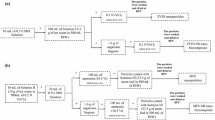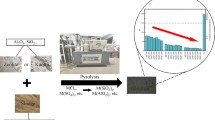Abstract
To eliminate the environmental damage of high water content dredging sludge and industrial waste containing heavy metals, these wastes are dewatered and stored. Dewatering is based on the principle of solid–liquid separation. One of the most effective methods for dewatering is the removal of water from the environment by mixing various synthetic polymers into the soil slurry by providing rapid flocculation of solid particles. Although it offers fast and affordable solutions, it makes it necessary to conduct experimental studies to determine the effective polymer type and dose to be used according to the soil type in each project site. The most commonly used experimental method for determining the effective polymer and its dose is the jar test. In this study, using the Seyitömer fly ash as industrial waste, experimental factors affecting the results in the jar test were investigated. The settling time of the slurry, mixing speed, mixing time, temperature, and storage time of the polymer solution was determined to have a significant effect on the jar test results, and these factors must be taken into account. In the jar tests, the settling time of 2–4 min, the mixing speed of 200–250 rpm, the mixing time of 3 min, and the 20 °C ambient temperature were determined as the most effective range to determine the effective polymer and its dose. Furthermore, it was experimentally determined that the polymer solution can be used for solid–liquid separation without a decrease in its effectiveness for 16 days after 24 h after it was prepared.
















Similar content being viewed by others
Data availability
The data and material used in this research are partly available in the body of the article; other data/materials are also available to public and will be provided through writing to the authors.
References
Al-Mutairi NZ, Hamoda MF, Al-Ghusain I (2004) Coagulant selection and sludge conditioning in a slaughterhouse wastewater treatment plant. Bioresour Technol 95:115–119. https://doi.org/10.1016/j.biortech.2004.02.017
American Society for Testing and Materials (ASTM), ASTM C618 (1998) Standart specification for coal fly ash and raw or calcined natural pozzolan for use as a mineral admixture in concrete. Annual Book of ASTM Annual Book of ASTM Standards: Pennsylvania
American Society for Testing and Materials (ASTM), ASTM D2035–19 (2019) Standard practice for coagulation-flocculation jar test of water. West Conshohocken, PA, United States. ASTM International. http://www.astm.org
Cengiz I, Sabah E, Erkan ZE (2004) A study on the flocculation performance of conventional and UMA (unique molecular architecture) technology polymers. Scientific Mining Journal 43(1):15–23
Cetin D, Sengul T, Bhatia SK, Khachan MM (2017) Effect of polymer and fiber usage on dewatering and compressibility behavior of fly ash slurries. Mar Georesources Geotechnol 35:678–687. https://doi.org/10.1080/1064119X.2016.1217106
Cetin D, Sengul T, Khachan MM, Bhatia SK, Owen SO (2014) Dewatering performance of fiber reinforced fly ash slurry, New Front. Geotech. Eng. GSP 243 © ASCE, pp. 98–107
Choi HJ (2017) Application of surface modified sericite to remove anionic dye from an aqueous solution. Environmental Engineering Environ Eng Res 22(3):312–319
Dorum A, Koçak Y, Yılmaz B, Uçar A (2010) The effect of electrokinetic specification features to hydration development in fly ash blended cement. J Fac Eng Arch Gazi Univ 25(3):449–457
Duggan KL, Morris M, Bhatia SK, Khachan MM, Lewis KE (2019) Effects of cationic polyacrylamide and cationic starch on aquatic life. J Hazard Toxic Radioactive Waste 23(4):04019022. https://doi.org/10.1061/(ASCE)HZ.2153-5515.0000467
Fatema N, Bhatia SK, Grady WF (2018) Comparison of 1-D and 2-D geotextile dewatering tests with fly ash slurry. Proceedings of the 11th International Conference on Geosythetics; 2018 Sep 16–21; Seoul, Korea, Republic of. Seoul: Korean Geosynthetics Society
Grzelak MD, Maurer BW, Pullen TS, Bhatia SK, Ramarao BV (2011) A comparison of test methods adopted for assessing geotextile tube dewatering performance. Geo-Frontiers 2011: advances in geotechnical engineering. Geotechnical Special Publication, Dallas, TX, pp 2141–2151
Karaguzel C, Can MF, Sönmez E, Çelik MS (2005) Effect of electrolyte on surface free energy components of feldspar minerals using thin-layer wicking method. J Colloid Interface Sci 285:192–200
Khachan MM, Bhatia SK, Bader RA, Cetin D, Ramarao BV (2014) Cationic starch flocculants as an alternative to synthetic polymers in geotextile tube dewatering. Geosynth Int 21:119–136. https://doi.org/10.1680/gein.14.00003
Khachan MM, Bader RA, Bhatia SK, Maurer BW (2011) Comparative dewatering performance of slurries conditioned with synthetic polymers vs. eco-friendly polymers. In: Geo-Frontiers 2011: advances in geotechnical engineering, Geotechnical Special Publication, Dallas, TX, pp 3050–3058
Li T, Zhu Z, Wang D, Yao C, Tang H (2006) Characterization of floc size, strength and structure under various coagulation mechanisms. Powder Technol 168:104–110. https://doi.org/10.1016/j.powtec.2006.07.003
Maurer BW, Gustafson AC, Bhatia SK, Palomino AM (2012) Geotextile dewatering of flocculated, fiber reinforced fly-ash slurry. Fuel 97:411–417. https://doi.org/10.1016/j.fuel.2012.02.013
Ngadi N, Yahya NY, Muhamad N (2013) Treatment of ındustrial textile wastewater using polyarcrylamide (PAM) and polyaluminium chloride (PAC). Jurnal Teknologi 60:41–44
Sabah E, Cengiz I (2004) An evaluation procedure for flocculation of coal preparation plant tailings. Water Res 38:1542–1549. https://doi.org/10.1016/j.watres.2003.12.017
Spritzer JM, Khachan MM, Bhatia SK (2015) Influence of synthetic and natural fibers on dewatering rate and shear strength of slurries in geotextile tube applications. Int J Geosynth Ground Eng 1:26
Taşdemir T, Erdem V (2010) Removal of suspended particles from wastewater using flocculation method. J Eng Archit Fac Eskişehir Osmangazi Univ 23(1):109–112
Tassinari B, Conaghan S, Freeland B, Marison IW (2015) Application of turbidity meters for the quantitative analysis of flocculation in a jar test apparatus. J Environ Eng 141:04015015. https://doi.org/10.1061/(ASCE)EE.1943-7870.0000940
Vidyadhar, A., Kumari, N., & Bhagat, R. P. (2012). Flotation of quartz and hematite: adsorption mechanism of mixed cationic/anionic collector systems, XXVI International Mineral Processing Congress Proceedings, 244 – 251
Worley JW, Bass TM, Vendrell PF (2008) Use of geotextile tubes with chemical amendments to dewater dairy lagoon solids. Biores Technol 99(10):4451–4459
Zhu X, Reed BE, Lin W, Carriere PE, Roark G (1997) Investigation of emulsified oil wastewater treatment with polymers. Sep Sci Technol 32:2173–2187. https://doi.org/10.1080/01496399708000762
Author information
Authors and Affiliations
Corresponding author
Ethics declarations
Conflict of interest
The authors declare no competing interests.
Additional information
Responsible Editor: Zeynal Abiddin Erguler
We confirm that neither the manuscript nor any parts of its content are currently under consideration or published in another journal.
Highlights
• Various synthetic polymers were used in the dewatering of the fly ash from a thermal power plant.
• Polymers are highly effective in the settling of waste soil particles in aqueous form.
• Flocculation mechanism is complex due to the presence of many reasons affecting flocculation, and a wide variety of polymers.
• Although the jar test method, commonly used in the literature, was adopted to determine the effective polymer and its dose, there is no specific standard.
• The effects of the optimum mixing speed of the suspension, mixing and settling times, ambient temperature, and effective use times of polymers on the determination of the polymer type and dose to be used in solid-liquid separation have been experimentally determined.
• By determining the appropriate polymer type and its dose, excessive polymer consumption can be prevented and economic and environmental health can be protected.
Supplementary Information
Below is the link to the electronic supplementary material.
Rights and permissions
About this article
Cite this article
Sengul, T., Bulut, A. Determination of the factors affecting the efficiency of the polymer in solid–liquid separation with synthetic polymers. Arab J Geosci 15, 858 (2022). https://doi.org/10.1007/s12517-022-10108-3
Received:
Accepted:
Published:
DOI: https://doi.org/10.1007/s12517-022-10108-3




